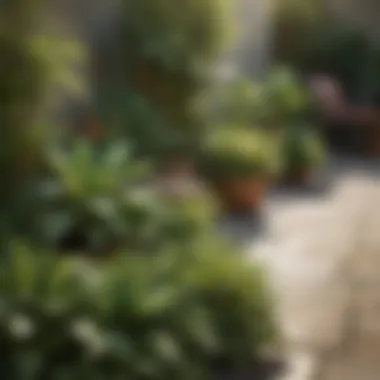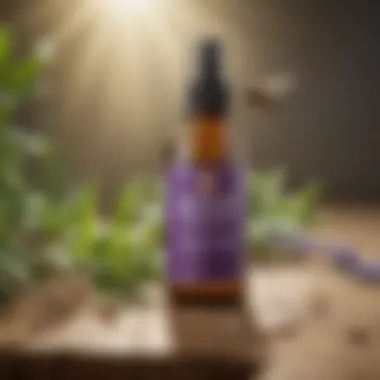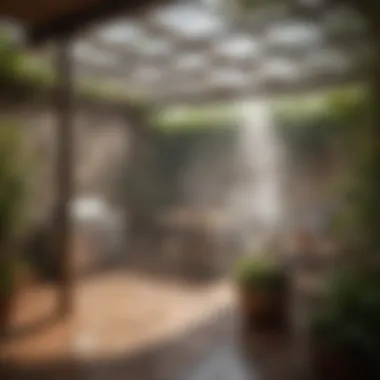Effective Mosquito Repellent for Your Outdoor Patio


Intro
As summer approaches, outdoor patios transform into centers of social life, gatherings, and relaxation. However, the presence of mosquitoes can hinder this enjoyment. Understanding what mosquito repellents are the most effective for outdoor settings is crucial. It allows one to choose wisely between the myriad of options available on the market today. This guide will unravel the complexities of selecting the right repellent, safe application methods, and how different products can perform under diverse conditions.
The focus will be on both chemical and natural repellents. This balanced view will provide insights into their respective mechanisms of action and efficacy. Whether one prefers DEET-based products or wishes to explore essential oil alternatives, the aim remains the same: a peaceful outdoor experience free from buzzing nuisances.
Furthermore, being aware of safety guidelines is essential, especially for families with children or pets. By delving into the details of each repellent option, readers can make informed decisions that suit their specific outdoor environments. With this guide, one can approach the season with confidence, ready to enjoy the beauty of alfresco living without distractions.
This discourse will address key points such as:
- The various types of mosquito repellents available.
- The factors that influence the effectiveness of these products.
- How to safely apply these repellents for maximum protection.
This comprehensive exploration will ensure a thorough understanding of the topic at hand.
Preamble to Mosquito Challenges
Mosquitoes are more than just a nuisance during outdoor gatherings; they pose serious challenges to enjoying patios and outdoor spaces. Understanding these challenges is crucial for designing effective strategies to repel these pests. Selecting the right mosquito repellent helps not only in maximizing comfort but also in safeguarding health.
Understanding Mosquito Behavior
To effectively combat mosquitoes, one must first comprehend their behavior. Mosquitoes are attracted to carbon dioxide, body heat, and certain body odors. They breed in stagnant water, which creates a habitat close to our outdoor spaces. This knowledge allows us to choose the right times for outdoor activities and to take necessary precautions. It is also relevant to understand their peak activity periods, usually dawn and dusk, which inform potential repellent strategies.
Importance of an Outdoor Patio
An outdoor patio serves as an extension of living space. It's a place for meals, relaxation, and socializing. However, the presence of mosquitoes can disrupt these activities significantly. The outdoor environment offers numerous opportunities for leisure and recreation but also for pest invasions. Thus, ensuring a comfortable atmosphere by utilizing effective mosquito repellents becomes vital. By being proactive about pest management, individuals can maximize their enjoyment of outdoor patios, contributing positively to overall well-being.
Types of Mosquito Repellents
Understanding the various types of mosquito repellents is essential for effectively managing the mosquito problem on your outdoor patio. Different formulations offer distinct advantages and disadvantages that can cater to specific needs, preferences, or environmental concerns. It is crucial to evaluate the options available to ensure comfort and safety during outdoor activities. This section outlines the main categories of repellents: chemical, natural, and electronic or physical devices. Each type behaves differently and serves various purposes. By exploring these options comprehensively, we aim to empower readers with the knowledge to make informed choices.
Chemical Repellents
Chemical repellents have been a go-to for many seeking relief from mosquitoes. Primarily, these products contain active ingredients that mask the scent humans emit, thus reducing the likelihood of mosquito bites. The two most common chemical repellents are DEET and Picaridin, both of which have proven effectiveness.
DEET: Mechanism and Effectiveness
DEET, or N,N-diethyl-meta-toluamide, is a well-known chemical repellent. Its mechanism involves interfering with the sensory receptors of mosquitoes. This interference makes it difficult for mosquitoes to detect humans. Many studies confirm its effectiveness, making it a staple in repellent products. One of the key characteristics of DEET is its varied concentration levels, ranging from 5% to 100%. This versatility allows users to select a product tailored to their specific outdoor exposure time.
However, there are considerations. Some may find DEET's odor unpleasant. Additionally, it can be harmful to certain materials, like plastics. Therefore, care is needed during application and storage.
Picaridin: A Synthetic Alternative
Picaridin serves as a modern alternative to DEET. Its structure and effectiveness mirror that of DEET, but its advantages lie in its usability. This compound is less oily than DEET, leading many to favor it for comfortable application. The characteristic that stands out is its enduring effect, providing up to 14 hours of protection without a strong odor.
Despite its benefits, Picaridin could potentially be less effective against certain species of mosquitoes when compared to DEET. Thus, knowing the local mosquito population can influence the choice.
Oil of Lemon Eucalyptus: A Natural Compound
Oil of Lemon Eucalyptus is another popular choice among chemical repellents. This natural compound, derived from the leaves of the Eucalyptus citriodora tree, is noted for its strong properties against mosquitoes. Its mechanism involves causing a strong scent, disrupting the mosquito's ability to locate humans. Its key characteristic is that it offers long-lasting effects comparable to some synthetic options when used correctly.
Though it stands out for its natural origins, it is crucial to mention that the oil can cause skin irritation in some individuals. Overall, Oil of Lemon Eucalyptus is favorable for those seeking a more natural approach while still benefitting from effective repellence.
Natural Repellents
Natural options for mosquito repelling have gained popularity among those who seek eco-friendly and non-toxic solutions. They typically contain botanicals and essential oils that exhibit insect-repellent properties, which can be advantageous for health-conscious users.
Citronella: Traditional Yet Effective
Citronella oil is perhaps the most recognized natural repellent. Extracted from citronella grass, this oil has been used for years to keep mosquitoes at bay. Its key characteristic is that it masks the scents humans emit, creating a less attractive environment for mosquitoes. People often use it in candles, sprays, and diffusers.
However, its effectiveness can be shorter in duration compared to chemical options, often lasting only a couple of hours. Thus, frequent reapplication may be necessary, which could be inconvenient for some.


Essential Oils: Varieties and Usage
Essential oils encompass a broad range of plant-derived substances, such as lavender, peppermint, and tea tree oil. Each oil has its unique properties. For example, lavender is known for its calming scent, while peppermint can produce a cooling sensation. Users can find these oils in sprays, lotions, or even diffused in a space.
One major consideration is that certain essential oils require dilution if used directly on skin. Additionally, while pleasant, their protective duration may not match that of synthetic options. A good understanding of various oils helps in effective use.
Plants that Repel Mosquitoes
Incorporating plants that repel mosquitoes adds both beauty and functionality to your outdoor patio. Species such as marigolds, basil, and rosemary can deter mosquitoes effectively. The key characteristic here lies in their natural scent, which can interfere with mosquito navigation.
However, relying solely on plants may not provide sufficient protection. Their effectiveness is generally less than that of chemical options, making them best used as a supplementary measure rather than a primary defense.
Electronic and Physical Devices
The market now offers various electronic and physical devices aimed at mosquito control. These devices provide alternative methods for repelling insects without relying solely on topical applications.
Ultrasonic Devices: Do They Work?
Ultrasonic devices are marketed as a way to repel blood-feeding insects using high-frequency sounds. The theory is that these frequencies are irritating to mosquitoes, causing them to stay away. However, scientific evidence regarding their effectiveness remains polarizing, with many studies indicating minimal impact.
A great aspect of these devices is their ease of use. They provide a maintenance-free solution that does not require direct application on the skin. Yet, it is essential to manage expectations regarding their effectiveness, especially in areas with heavy mosquito populations.
Bug Zappers: How Effective Are They?
Bug zappers attract mosquitoes and other insects using light, directing them into an electrified grid. Their effectiveness varies, as they primarily lure insects that are attracted to light instead of carbon dioxide – which is a primary attractant for mosquitoes.
While they help reduce the overall insect population, they may not eliminate mosquitoes effectively in a specific area. Their presence can be a useful addition to a larger strategy that incorporates other methods.
Fans and Wind as Deterrents
Using fans or creating wind can be an effective and natural way to keep mosquitoes at bay. Mosquitoes are weak flyers, and increased wind speed can make it difficult for them to navigate. This characteristic makes fans practical tools for outdoor settings, especially during gatherings. By simply circulating air, you can add an extra layer of comfort while enjoying your patio.
Moreover, using fans has no side effects compared to chemical alternatives. However, implementing this method may require more power consumption, which could pose a minor inconvenience.
Effective mosquito control often combines multiple strategies. Understanding these repellents collectively enhances the chances of a mosquito-free environment.
Evaluating Repellent Effectiveness
Assessing the effectiveness of mosquito repellents is crucial for anyone looking to enjoy their outdoor patio without the incessant buzz of mosquitoes. Various factors determine how well a repellent works and understanding these can lead to more informed choices, ultimately enhancing outdoor experiences. The performance of a repellent does not solely depend on its composition but also on other external elements that influence how effectively it can ward off these pests. Evaluating effectiveness ensures that one selects a product appropriate for their specific patio environment and needs.
Factors Affecting Repellent Performance
Application Method: Skin vs. Surrounding
The method of application plays a significant role in how effective a mosquito repellent will be. Applying repellents directly to the skin provides immediate protection. This method is popular because it creates a barrier between the skin and any mosquito bites. The direct application allows the repellent to be absorbed by the skin, maximizing contact with potential pests. However, one should be cautious as some people may have skin sensitivities to certain chemicals. On the other hand, applying repellents to surrounding areas can also be beneficial. This technique can create a deterrent zone, making the patio less attractive to mosquitoes.
Ultimately, the choice between skin or surrounding application depends on the setting and the individual's circumstances. Some prefer a combination of both to enhance protection.
Environmental Conditions: Heat and Humidity
Environmental conditions greatly influence the performance of mosquito repellents. Heat can evaporate chemical compounds in sprays quickly, diminishing their effectiveness. Humidity can have a similar effect, allowing mosquitoes to thrive, as they are more active in damp conditions. Areas that are regularly humid may require more frequent applications compared to drier regions. This variable makes it necessary to consider the outdoor climate when choosing a repellent. It can determine how often one must reapply repellents to maintain effective protection on a patio.
Understanding the climate and conditions surrounding the patio is essential for taking proper measures. It also highlights the need for a proactive approach to mosquito management.
Duration of Protection Offered
The duration of protection is another key characteristic when evaluating mosquito repellents. Different products may offer varying lengths of effective mosquito deterrence. Some repellents may provide several hours of protection, whilst others need reapplication every few hours. Choosing a product with a longer duration can be a time-saver and allows longer enjoyment of outdoor spaces without constant interruptions for reapplication. However, it’s crucial to balance duration with safety. Repellents with prolonged effects may contain higher concentrations of chemicals, which require careful consideration of potential side effects.
Each product has unique features and different active ingredients that contribute to how long it can protect against mosquitoes. Thus, knowing the average duration of a product’s effectiveness aids in planning outdoor activities and deciding when to apply the repellent.
Reading Product Labels


Understandably, product labels provide critical information about the ingredients and suggested usage. They offer insights into what to expect in terms of protection and application recommendations. Recognizing active ingredients, safety precautions, and effectiveness duration helps in selecting the right repellent. Making informed decisions about which product to use allows users to tailor their mosquito defense strategies more effectively.
Application Techniques for Patios
Understanding how to effectively apply mosquito repellents is crucial for achieving a comfortable outdoor experience. The right application techniques can significantly reduce the mosquito population around your patio, leading to less irritation during outdoor activities. This section outlines vital steps in repellent application, emphasizing preparatory actions and effective methods.
Pre-Outdoor Preparation
Prior preparation sets the stage for successful mosquito repellent application. It is essential to address several key factors that can enhance the effectiveness of any repellent.
Clearing Standing Water
One of the most important actions in pre-outdoor preparation is clearing standing water. Mosquitoes thrive in stagnant water, where they lay eggs and develop. By removing or regularly servicing areas of standing water, you reduce the potential mosquito breeding sites nearby. This practice is especially critical for patio areas where water can accumulate due to plant pots, bird baths, or unintended pooling. A clear area minimizes mosquito presence, making it a beneficial component in your outdoor strategy.
Some advantages are:
- Reduces local mosquito populations
- Encourages a cleaner outdoor space
- Increases overall enjoyment of the patio area
Choosing the Right Time for Application
The time you choose to apply repellents can play a significant role in their effectiveness. Choosing the right time for application means considering peak mosquito activity hours, which often occur during dawn and dusk. Applying repellents during or just before these periods can enhance their success rate. Moreover, many repellents have a limited duration of effectiveness, thus timing the application can maximize protection.
Key benefits include:
- Enhanced protection when mosquitoes are most active
- Better alignment of protection with outdoor events
- Potentially fewer reapplications required
Preparing the Patio Area
Preparing the patio area is another crucial step that contributes to a successful outdoor experience. This preparation can involve arranging furniture to allow airflow or removing items that can collect water. Ensuring that the patio is tidy not only makes it more pleasant but also can lower the likelihood of mosquitoes finding shelter nearby. A clear and well-maintained patio can create an inviting space that is less attractive to pests.
Some of the aspects are:
- Improved airflow can make the space less inviting to mosquitoes
- Reduces clutter that can trap humidity and water
- Promotes a visually appealing and functional area
How to Apply Repellents Effectively
After preparing the patio, understanding various application methods is necessary for effective mosquito control. Each method has unique aspects and benefits that cater to different preferences and situations.
Direct Application: Skin and Clothing
Direct application of mosquito repellents onto skin and clothing is the most straightforward method. This technique involves applying a suitable repellent directly to exposed skin or clothing to create a protective barrier. The advantage of this approach lies in its direct targeting of the user. It offers immediate protection against mosquito bites while providing flexibility.
However, care must be taken to follow safety guidelines to avoid skin irritation. Key points include:
- Immediate protection against bites
- Easy control over areas needing protection
- Good for personal usage but requires thorough application
Using Sprays and Mists
Using sprays and mists offers broad coverage, making this method popular for larger areas. Sprays can be applied not only to the skin but also around the patio area to create a barrier against mosquitoes. The primary characteristic of this method is its ability to cover larger surfaces quickly. Effective application ensures that both the users and the surrounding area are protected.
Advantages of sprays include:
- Quick application across larger spaces
- Potential residual effects prolonging protection
- Versatility in use—can be applied on areas without exposure to individuals
Setting Up Diffusers and Candles
Setting up diffusers and candles presents a different approach to mosquito repelling. Instead of applying repellents directly, this method utilizes diffusion of essential oils in the surrounding area. It can create a pleasant ambiance while acting as a deterrent for mosquitoes. Citronella candles, for instance, are a common choice that provides both aesthetic benefits and a repelling effect.
Unique features of this method include:
- Offers a multi-sensory experience—sight and smell
- Can enhance the overall atmosphere of outdoor gatherings
- May require more frequent replacement or maintenance for ongoing effectiveness


By understanding these application techniques and pre-outdoor preparations, you can attain a more enjoyable patio experience while effectively managing mosquito presence.
Safety and Environmental Considerations
The discussion of mosquito repellents is incomplete without addressing safety and environmental considerations. As outdoor spaces are enjoyed more frequently, understanding the implications of the repellents we choose becomes crucial. It is not just about keeping mosquitoes at bay; it also involves ensuring that the methods we employ do not inadvertently harm ourselves, surrounding people, or the ecosystem. This section elaborates on health risks associated with chemical repellents, their impact on pollinators and wildlife, and best practices for their safe use.
Health Risks of Chemical Repellents
Chemical repellents, while effective, come with a spectrum of health risks. Compounds like DEET are commonly known for their efficacy in repelling mosquitoes, but extended exposure can lead to skin irritation or allergic reactions in some individuals.
Studies show that high concentrations may cause neurotoxicity, particularly in young children. If a person has sensitive skin, it's advisable to conduct a patch test before full application. Moreover, pregnant women should consult occupational guidelines and health professionals before using any chemical repellents, as some ingredients may pose avoidable risks to fetal development.
A careful approach to selecting repellents is essential for maintaining health safety.
Impact on Pollinators and Wildlife
The ecological impact of chemical repellents can be significant. These products may inadvertently affect non-target species such as honeybees and butterflies, which are vital for pollination. Many chemical compounds do not discriminate between pests and beneficial insects, leading to declines in their populations.
Aquatic ecosystems are also at risk. Runoff from treated areas can carry remnants of these chemicals into waterways, jeopardizing fish and other aquatic organisms. Natural repellents, while often less effective, present a more sustainable choice with reduced ecological footprints, thus supporting biodiversity.
Best Practices for Safe Use
To maximize effectiveness while minimizing risks, adhering to best practices is necessary. First, it is important to read and follow the product labels thoroughly. This ensures correct application and dosage.
Applying chemical repellents only to exposed skin and clothing—never directly on the face—can help mitigate exposure. Additionally, it's prudent to choose a time for application when winds are low and conditions are stable, reducing the possibility of drift to unintended areas.
For those seeking alternatives, using natural repellents in combination with physical barriers such as screens allows for a proactive approach without compromising safety.
In summary, understanding the safety and environmental implications of mosquito repellents is essential. This knowledge empowers individuals to make informed decisions that align with both personal health and ecological responsibility.
Case Studies and Real-World Applications
Understanding how different mosquito repellents function in real-life scenarios is critical. Case studies offer valuable insights into the effectiveness of various strategies used in patio settings. Readers gain perspective on practical results achieved by users, guiding them in selecting the most suitable option. These examples support theoretical knowledge and create confidence in decision-making regarding mosquito control. By analyzing actual experiences, one can grasp the nuances of effectiveness, adaptability, and user satisfaction with the different approaches.
Patio Use Cases: Success Stories
Several instances showcase the success of specific repellents in outdoor patio settings. For example, a family in Florida adopted a combined approach using chemical repellents and plant-based alternatives. They found that applying a DEET-based spray before evening activities significantly reduced mosquito presence. Moreover, placing citronella candles on their patio created a pleasant ambiance while providing additional protection.
Another situation involved a community event at a local park. Organizers used a combination of insect-repelling plants, like lavender and marigold, alongside ultrasonic devices. Feedback from attendees highlighted fewer mosquito bites during the evening. This case highlighted that integrating multiple deterrents can enhance overall effectiveness by attacking the problem from different angles.
Comparative Analysis of Repellent Types
When evaluating the effectiveness of mosquito repellents, comparisons of various types are crucial. A case study that analyzed chemical versus natural repellents showed distinct differences in user experiences. While some individuals prefer the immediate efficacy of chemical products like Picaridin, others opted for essential oils for their natural appeal.
Research outlines the trade-offs related to duration and intensity of protection. Chemical repellents often provide longer-lasting effects but may raise health concerns. Conversely, natural alternatives like oil of lemon eucalyptus are safer but might require more frequent application.
In addition, users discuss the practicality of electronic devices. Reviews indicate that while devices like bug zappers can eliminate mosquitoes, they are not always effective in large open areas. Some users reported dissatisfaction due to limited coverage compared to sprays or candles.
Ultimately, this comparative analysis encourages consumers to assess their preferences and environmental goals. Choosing the right mosquito repellent depends on balancing efficacy, safety, and user experience.
Closure
In the increasingly connected world of outdoor leisure, understanding effective strategies for mosquito repellent use is paramount. This article addresses the myriad challenges posed by mosquitoes. As discussed, knowing what features to look for in both chemical and natural repellents can greatly improve outdoor experiences.
Summarizing Effective Strategies
Several key strategies emerge from this exploration:
- Choose the Right Repellent: Select repellents based on your needs, considering both efficacy and safety. DEET, Picaridin, and natural options like citronella come with their own sets of advantages.
- Application Techniques Matter: Effective application can enhance protection. Apply repellent directly to skin and clothing, as well as around the patio area. Creating a barrier can be essential.
- Prevention is Crucial: Address existing mosquito habitats by removing standing water. Being proactive will save you from overwhelming mosquito populations later.
- Stay Informed About Weather: Environmental factors play a role in effectiveness. Humidity and temperature can influence how long a repellent remains active.
- Monitor Effectiveness Regularly: Regularly assess your chosen repellent’s effectiveness and adjust if necessary. Be open to trying new products as they become available.
By integrating these strategies, patio users can vastly improve their outdoor experiences, mitigating the nuisance of mosquitoes.
Future Directions in Mosquito Repellents
The future looks promising for mosquito repellent development, with several trends gaining traction:
- Innovative Ingredients: Research into plant-based and synthetic compounds continues. New findings may lead to more effective and eco-friendly repellents.
- Data-Driven Solutions: Advances in technology allow for monitoring mosquito populations and behaviors. Applications may use this data to recommend the best repellents and strategies for specific environments.
- Customized Products: Tailored repellents based on individual needs or specific outdoor environments are on the horizon. Personalization could elevate effectiveness and comfort.
- Integrative Approaches: Combining repellents with ecological practices, like using native plants for natural deterrence, could form a holistic method to combat mosquitoes.
- Regulatory Awareness: As new products enter the market, increased regulatory scrutiny may demand transparency and reveal key insights into their safety and efficiency.
Enhancing our understanding of both current methods and emerging trends will prepare us for the evolving landscape of mosquito control, paving the way for more enjoyable outdoor experiences.







